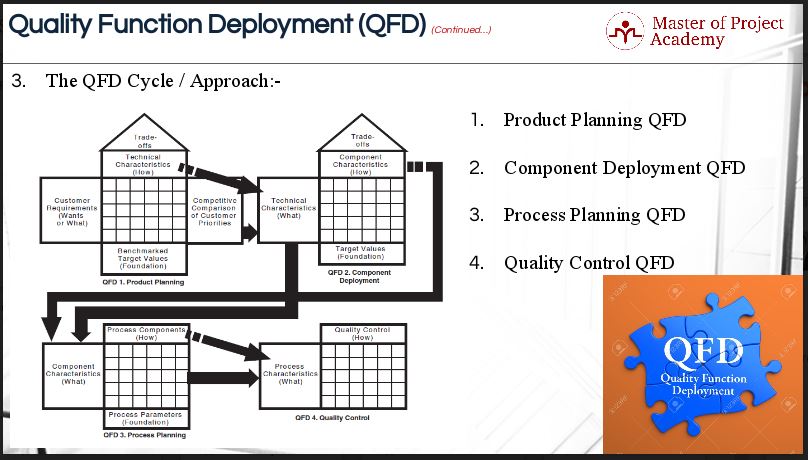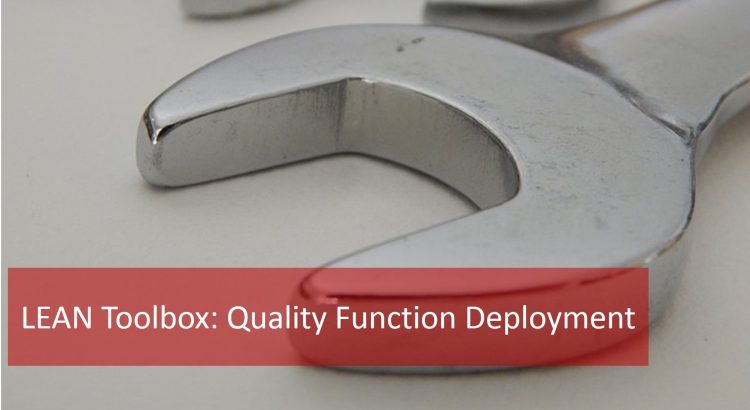Quality function deployment is a LEAN technique that is a little out of scope for Six Sigma Green Belt practitioners and more useful for Black Belt practitioners. Yet, it is a powerful tool to design processes or products according to customer requirements. Quality function deployment is abbreviated as QFD. It fits into the Define phase of the DMAIC structure as briefly stated in the online free Six Sigma training. It is one of many LEAN techniques in the LEAN toolbox that are discussed in Six Sigma Green Belt training. Let’s talk about quality function deployment!
Attend our 100% Online & Self-Paced Free Six Sigma Training.
Quality Function Deployment Definition
Once information about customer expectations has been obtained, techniques such as quality function deployment can be used to link the voice of customer directly to internal processes. QFD is not only a quality tool but also an important planning tool. It allows the consideration of the “voice of the customer” along the service development path to market entry.
There is no single definition for quality function deployment, but a general basic concept of this method is as follows:
“Quality Function Deployment is a system with the purpose of translating and planning the VoC into the quality characteristics of products, processes and services for reaching customer satisfaction”
History of QFD
The tool was first used to design an oil tanker at the Kobe shipyards of Japan in 1972 by Yoji Akao and Shigeru Mizuno to design customer satisfaction into a service offering before it is produced. Prior to this, quality control methods were primarily aimed at fixing a problem during or after production. In the mid-1980s, Don Clausing of MIT introduced this design tool to the United States. A classic product design application is in the automotive industry. In fact, Clausing tells of an engineer who initially wanted to place the emergency hand brake of a sports car between the seat and the door. However, the voice of customer testing found that women drivers wearing skirts had difficulty with the new placement of the hand brake. The Quality Function Deployment highlighted potential dissatisfaction with the location of this feature, and the idea was scrapped.

Benefits of QFD
- Quality Function Deployment is a powerful prioritization tool that combines several different types of matrices into one to form a house-like structure.
- Quality Function Deployment is a customer-driven process for planning products and services.
- It starts with the voice of the customer, which becomes the basis for setting requirements.
- Quality Function Deployment provides documentation for the decision-making process.
- QFD helps you to:
- Translate customer requirements into specific offering specifications
- Prioritize possible offering specifications and make trade-off decisions based on weighted customer requirements and ranked competitive assessment
The QFD technique is based on the analysis of the clients’ requirements, which normally are expressed in qualitative terms, such as: “easy to use”, “safe”, “comfortable” or “luxurious”. In order to develop a service, it is necessary to “translate” these fuzzy requirements into quantitative service design requirements; QFD makes this translation possible. Quality Function Deployment is also a system for design of a product or service based on customer demands, a system that moves methodically from customer requirements to specifications for the product or service. QFD involves the entire company in the design and control activity. Finally, QFD provides documentation for the decision-making process
QFD House of Quality Matrices
QFD matrices also called “the house of quality”, are graphical displays of the result of the planning process. QFD matrices vary a great deal and may show such things as competitive targets and process priorities. The matrices are created by interdepartmental teams, thus overcoming some of the barriers which exist in functionally organized systems
In this figure, we can see the QFD diagram. In its most complete state, this information constructs the five “rooms” in the QFD house.

- The What or Wants: Customer requirements, needs, and priorities that form the far left-wing of the house
- The Competitive Assessment: Compares customer priorities with appropriate marketplace offerings, across key competitive deployments, which forms the right-wing annex of the house
- The How: The offering’s technical design features, functionality, and characteristics to meet the customer requirements. This forms the attic of the house
- The Design Relationships: Describes the interrelationship between the design features, which form the roof of the house
- The Foundation: Uses benchmarked target values as objective measurements to evaluate each characteristic, forming the basement of the house
Quality Function Deployment Process
Let us briefly have a look at the QFD approach; which is used for the purpose of designing an error free process or product. In this approach, design engineers typically start progressive drill-down approach with planning the development and go through four phases to reach a deeper understanding of the required process control and quality. The details are as follows:
- Product Planning QFD. It helps identify service offerings characteristics, that best meet customer requirements, helps analyze competitive opportunities, and establishes critical target values too.
- Component Deployment QFD. It helps identify the critical parts and assembly components using the prioritized offering characteristics in QFD 1 and establishes critical target values.
- Process Planning QFD. It helps determine critical process operational requirements and elements using the prioritized components in QFD 2 and establishes critical process parameters
- Quality Control QFD. It helps prioritize the process control methods and parameters and establishes production and inspection methods that best support the prioritized process elements of QFD 3

The diagram shown here will also help you understand the QFD methodology here. Each matrix in the four-step approach is related to the previous matrix. Once the matrices are completed, Six Sigma Black Belt practitioners can use the information to design their process or product according to critical target values and customer requirements. Six Sigma is all about producing products or services that deliver on customer demands. Quality function deployment is just another way to design processes that produce products or services that satisfy the customer.



One thought on “What Is Quality Function Deployment (QFD) and Why Do We Use It?”
Comments are closed.